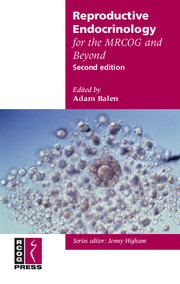Book contents
- Frontmatter
- Contents
- Acknowledgements
- Preface to the first edition
- Preface to the second edition
- Abbreviations used in this book
- 1 Sexual differentiation: intersex disorders
- 2 Adrenal disorders
- 3 Normal puberty and adolescence
- 4 Abnormal puberty
- 5 The menstrual cycle
- 6 Disorders of menstruation
- 7 Amenorrhoea
- 8 Polycystic ovary syndrome
- 9 Health consequences of polycystic ovary syndrome
- 10 Anovulatory infertility and ovulation induction
- 11 Lactation and lactational amenorrhoea
- 12 Hyperprolactinaemia
- 13 Thyroid disease
- 14 Diabetes
- 15 Lipid metabolism and lipoprotein transport
- 16 Premature ovarian failure
- 17 Calcium metabolism and its disorders
- Appendix: Endocrine normal ranges
- Further reading
- Index
6 - Disorders of menstruation
Published online by Cambridge University Press: 05 August 2014
- Frontmatter
- Contents
- Acknowledgements
- Preface to the first edition
- Preface to the second edition
- Abbreviations used in this book
- 1 Sexual differentiation: intersex disorders
- 2 Adrenal disorders
- 3 Normal puberty and adolescence
- 4 Abnormal puberty
- 5 The menstrual cycle
- 6 Disorders of menstruation
- 7 Amenorrhoea
- 8 Polycystic ovary syndrome
- 9 Health consequences of polycystic ovary syndrome
- 10 Anovulatory infertility and ovulation induction
- 11 Lactation and lactational amenorrhoea
- 12 Hyperprolactinaemia
- 13 Thyroid disease
- 14 Diabetes
- 15 Lipid metabolism and lipoprotein transport
- 16 Premature ovarian failure
- 17 Calcium metabolism and its disorders
- Appendix: Endocrine normal ranges
- Further reading
- Index
Summary
Disorders of menstruation are common. In a MORI national community survey in 1990, 1069 women aged 16–45 years were interviewed in their homes: 31% reported heavy periods and 38% painful periods. Of these, one-third had consulted a doctor within the past four months. The Fourth National Morbidity Survey in General Practice (1991–92) showed that for women aged 25–44 years the consultation rates for menorrhagia and dysmenorrhoea were 65 and 40 per 1000 person-years at risk, respectively, and that 5% of women aged 30-49 years consulted their GP for menor-rhagia in one year. When it comes to hospital referral, menstrual disorders are the second most common cause of all referrals for all ages and both sexes, which would appear to be a disproportionate use of health service resources by one-quarter of the population. Menorrhagia is the main presenting complaint in women referred to gynaecologists. About 73,000 hysterectomies and 10,000 endometrial ablations are performed annually in England, of which about two-thirds are undertaken for women presenting with menorrhagia.
Until recent years, by the age of 43 years one in ten women had undergone hysterectomy and 15% had undergone at least one dilatation and curettage (D & C) – the latter now considered to be obsolete, at least in the treatment of menorrhagia. The management of menorrhagia changed over the last two decades of the 20th century, with the introduction in the mid-1980s of therapeutic endoscopic endometrial destructive procedures and in 1995 of the levonorgestrel-releasing intrauterine device in the UK.
- Type
- Chapter
- Information
- Reproductive Endocrinology for the MRCOG and Beyond , pp. 53 - 76Publisher: Cambridge University PressPrint publication year: 2007

